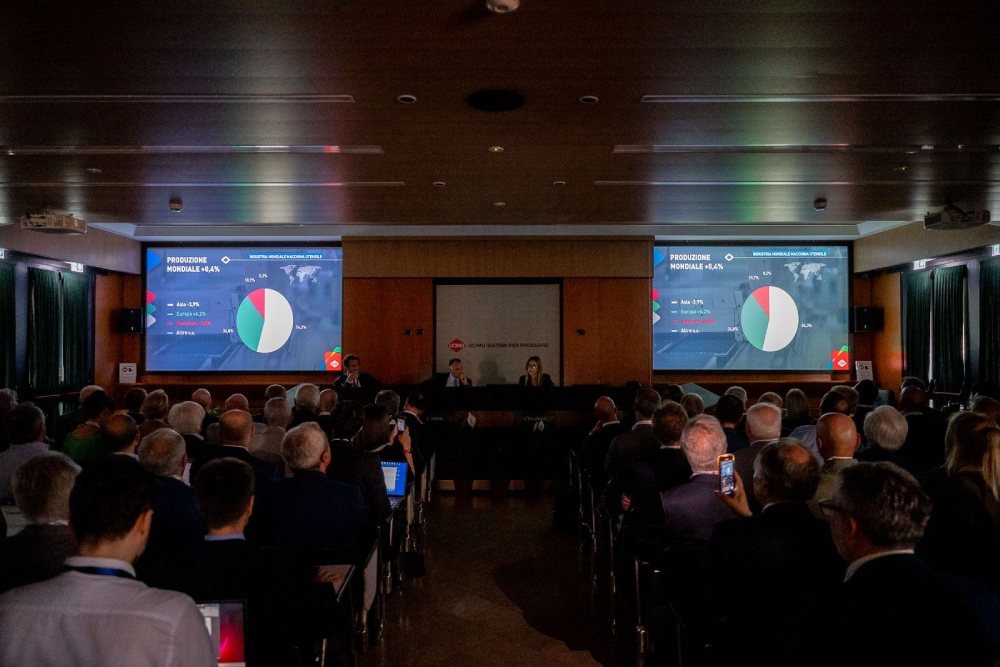UCIMU Projects Stable Export Growth Amid Domestic Slowdown for Italian Machine Tools in 2024

Cinisello Balsamo, Italy – The Italian machine tool, robot, and automation industry experienced a favorable year in 2023. However, the new production record was due only to the excellent export performance; domestic demand dropped. With these results, the Italian industry of the sector was confirmed once again among the key players of the international scenario, where it came in fifth place in the world ranking of production and fourth in that of exports and consumption.
The forecasts for 2024 are for a moderate decrease in production; the positive export trend is countered by a reduction in domestic deliveries, which are affected by the weakness of domestic demand. On the other hand, the slowdown in order intake in the first part of the year is the result of the uncertain context, both in Italy and abroad.
This is the framework summarized by Barbara Colombo, President, UCIMU-SISTEMI PER PRODURRE, during the Members’ Meeting, which was also attended by Emanuele Orsini, President, CONFINDUSTRIA (Italian Industrial Federation), interviewed by Simone Spetia, Radio 24.
The Final Figures 2023
According to the final figures compiled by the Economic Studies Department & Business Culture Centre of UCIMU, in 2023, the Italian production of machine tools, robots, and automation systems set a new record, attaining € 7,615 million, thus recording a 4.6 percent increase versus 2022. The outcome was solely due to the excellent performance achieved in the foreign market: exports reached a record value of € 4,223 million, corresponding to 21.8 percent more than in 2022.
Consumption decreased by 7.8 percent to € 5,816 million, penalizing Italian manufacturers’ deliveries, down by 11 percent to € 3,392 million, as well as imports, down by 3 percent to € 2,425 million. The export/production ratio was back on the rise, from 47.6 percent in 2022 to 55.5 percent in 2023.
In 2023, the main export markets for the Italian product offering were the United States (€ 567 million, +17.5 percent), Germany (€ 359 million, +17.2 percent), China (€ 286 million, +26.6 percent), France (€ 247 million, +28.2 percent), Poland (€ 215 million, +14.5 percent), Turkey (€ 211 million, +70.9 percent), Mexico (€ 195 million, +133.1 percent), Spain (€ 130 million, +9.4 percent), India (€ 117 million, +77 percent), and the United Kingdom (€ 85 million, +44.1 percent).
The utilization rate of production capacity was still high, showing a slightly decreased annual average, down from 86.6 percent in 2022 to 86.2 percent in 2023. The order portfolio also highlighted a moderate drop, standing at 7.3 months of guaranteed production versus 8 in the previous year.
The sector turnover amounted to € 11,012 million.
Forecasts 2024
Based on the forecasts made by the Economic Studies Department & Business Culture Centre of UCIMU, the year 2024 will show a slight contraction for the Italian machine tool, robot, and automation industry, whose performance will nevertheless remain at medium-high levels. The moderate decline recorded by all major economic indicators should be counterbalanced by the growth of exports, which should set a new record.
Production should reach € 7,450 million (-2.2 percent). Exports, still expected to grow (+3 percent), should achieve a new record of € 4,350 million. The worst trend will be that of domestic deliveries (-8.6 percent), which should stop at € 3,100 million, penalized by the reduction in domestic consumption, (-7.1 percent) falling to € 5,405 million. Imports should also record a downturn, standing at € 2,305 million (-4.9 percent).
On the other hand, in the first half year, the order collection of Italian manufacturers marked time. In the first six months of 2024, the UCIMU index went down by 17.3 percent compared to the same period of the previous year: -18.7 percent domestic orders and -16.2 percent foreign orders. This lackluster outcome was mainly due to the general conditions of instability in Italy and worldwide.
Comments and Proposals on Industrial Policy
Transition 4.0 and 5.0
Colombo states, “After a really striking two-year period, marked by double-digit growth for all the main economic indicators, the year 2023 was confirmed as favorable for the Italian industry of the sector, which set a new production record. However, the positive result was exclusively due to the great performance of exports that recorded a real upsurge.”
“This exploit proves, once again, the flexibility of Italian enterprises, capable of rapidly reorienting their business towards the most dynamic markets. However—adds the UCIMU President—at the same time, it highlights the clear weakness of the Italian market, which had already started to creak by the end of 2022.”
| “After all, the trend of the order intake in these last six months confirms the weakness of demand, which both in Italy and abroad is affected by the instability of the context. For the domestic market, even if this slowdown is partly expected, considering the exceptional expansion in the last two years, it is also true that the uncertainty about Transition 5.0 weighed on the result,” she continues. “The long wait for the measure to become operational and the lack of implementing decrees created a double negative effect. On one hand, they caused the suspension of purchasing decisions by users, waiting for the measure to become clear. On the other hand, they have, at least partially, obscured the availability of Measure 4.0, which is still in force, but which has ‘gone into oblivion’ for many operators.” |  |
Colombo explains, “With the entry into operation of Transition 5.0, which we hope will arrive within days, Italian manufacturing companies will have the opportunity to choose whether to operate with one or the other measure, well aware that 5.0 combines digital transformation and energy saving, whereas 4.0 continues to focus exclusively on the digital aspect. And there will be a remarkable ceiling of resources available, i.e., about € 13 billion in total: € 6.4 billion are the estimated resources for 4.0, whereas € 6.3 billion are the certain resources for 5.0 from the REPowerEU fund.”
She further states, “However, the point is that, if it does not become operational immediately, Transition 5.0 risks seeing a substantial part of the possible benefits vanish. The compressed time frame between the availability of the measure and the deadline for delivery and interconnection of machinery (set for December 2025), disadvantages Italian manufacturers, who specialize in super-customized products and have production times of about 6-8 months.”
“Even in consideration of the Government’s promise to work in support of Made in Italy, we think that this slowness is a real own goal, because, in fact, it risks favoring especially importers with large warehouses,” Colombo adds. “For this reason, I believe that, once Transition 5.0 is operational, CONFINDUSTRIA should immediately intervene with the authorities, so that the possibility of using the funds allocated by Europe for this measure can be extended to 2026.”
Availability of skilled personnel
State-of-the-art machines need people capable of managing, programming, and operating them. But they also impose a significant reorganization of company activities, requiring innovative approaches even for those figures that are not directly linked to production. “That is why UCIMU has strengthened—and will do so even more in the future—its commitment to UCIMU Academy, a project including all the initiatives dedicated to reducing the mismatch between job demand and supply, including degree thesis prizes, cooperation with ITS (Higher Technical Institutes), and all the work we carry out during our exhibitions,” says the UCIMU President.
“Among these, there is ROBOTGAMES, the new robotics and automation contest for young people from high schools, who will present their robotic automation prototypes with application to the world of industry. ROBOT GAMES will make its debut at BI-MU, the trade show for the sector, scheduled to take place at Fieramilano Rho next October,” she shares. “The jury will have to choose the 3 best among the 10 finalist teams. These are enthusiastic young people from all over Italy. It is an excellent message for all of us who work in the high-tech world: new generations are ready to follow us and work hard, applying their creativity to industry. We entrepreneurs have to be more and more careful to understand their aspirations and to approach and involve them.”
Internationalization
“The United States, China, India, Vietnam, and Mexico, obviously in addition to the European Union—says Colombo—are the countries to which we devote special attention. Exporting is our way of being present in these markets, but it cannot and should not be the only one. We still have to improve on this. In response to this need and driven by the Association, networks of enterprises have been created, aggregating different companies of the sector based in markets that are considered particularly attractive. To date, we have two networks: ITC India, which has been active for over 10 years, joined by IMT Vietnam last year.”
“Structuring ourselves to be really competitive on the global market is a long process. For this reason,—she stresses—it is important that the authorities strengthen the resources allocated to support the internationalization activities of companies, which include incoming missions of foreign operators, international trade fairs held in Italy, visit tours of Italian enterprises, and forums abroad presenting the most attractive sectors of Made in Italy. But I also think of the initiatives with SACE to cover export activities and with SIMEST to finance foreign development projects, as well as participation in international trade fairs around the world.”
“Moreover,—concludes the UCIMU president—if we observe the giants around us, we have to be aware that the size of companies and also that of countries do not play in our favor. That is why our belonging to the European Union will be more and more important: within the EU, we can contribute to steering programs, directives, and economic-industrial plans to the extent that we will be able to take part in strategic tables at all levels.”
Image Source: UCIMU-SISTEMI PER PRODURRE



 Facebook
Facebook.png) Twitter
Twitter Linkedin
Linkedin Subscribe
Subscribe